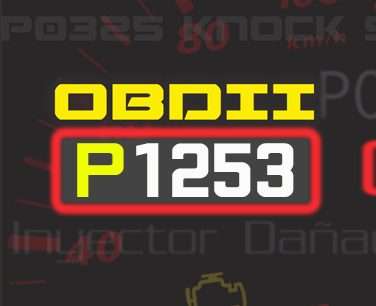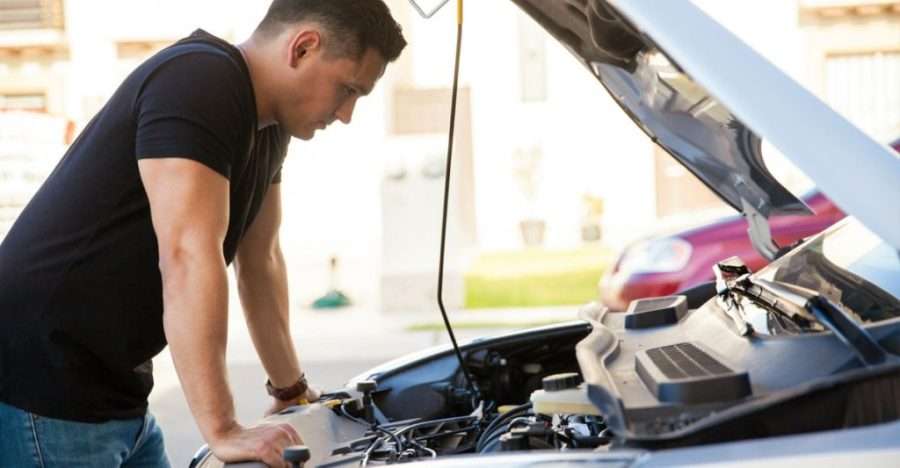
P1253 (Volkswagen, Audi, Skoda, Seat) Fuel consumption signal - short circuit to ground
Content
P1253 – OBD-II Trouble Code Technical Description
Trouble code P1253 indicates a short to ground in the fuel consumption signal circuit in Volkswagen, Audi, Skoda, Seat vehicles.
What does the fault code mean P1253?
Trouble code P1253 indicates a problem in the fuel signal circuit. It indicates the presence of a short circuit to ground in this circuit in Volkswagen, Audi, Skoda and Seat vehicles.
When the engine control module detects a short to ground in the fuel consumption signal circuit, it means that the signal transmitted from the associated fuel consumption sensor to the engine control module does not reach its intended level or is interrupted due to a short to ground. This may lead to misinterpretation of fuel consumption data, which may affect engine performance and efficiency.

Possible reasons
Trouble code P1253 can be caused by a number of different reasons:
- Damaged or broken wires: Damaged or broken wires in the electrical circuit can cause problems in transmitting the signal from the fuel flow sensor to the engine control unit (ECU).
- Corrosion or oxidation of contacts: Corrosion or oxidation on connector pins or wires can cause electrical problems and signal interruption.
- Damaged fuel flow sensor: The fuel consumption sensor itself may be damaged or malfunctioning, causing the fuel consumption data to be incorrectly read.
- Problems with the engine control unit (ECU): Malfunctions in the engine control module, such as electronics or software failures, can cause the P1253 code.
- Short circuit to ground: A short to ground in the fuel flow signal circuit can be caused by, for example, a broken wire insulation, which will cause the circuit to malfunction.
- Mechanical damage: Mechanical damage or physical impact on electrical circuit components can lead to malfunctions and short circuits.
- Faulty relays or fuses: Failure of the relays or fuses that control the electrical circuit can also cause P1253.
Determining the specific cause of the P1253 code requires detailed diagnostics of the electrical circuit and associated system components.
What are the symptoms of a fault code? P1253?
Symptoms for DTC P1253 may include the following:
- Increased fuel consumption: Incorrect or incorrect reading of fuel consumption data may result in increased fuel consumption. This may be noticeable in increased fuel consumption per kilometer or mile.
- Loss of engine power: Inaccurate fuel consumption data may cause the fuel injection system to malfunction, which may result in loss of engine power. This may manifest itself as less responsive acceleration or a noticeable deterioration in driving dynamics.
- Unstable engine operation: Incorrect fuel consumption reading may also cause engine instability. This may manifest itself as a rattling idle, rough idle, or jerky acceleration.
- “Check Engine” error appears: The vehicle's electronic control system may activate the Check Engine Light on the instrument panel to indicate a problem with the fuel injection system or fuel signal circuit.
- Unstable fuel consumption indicator on the dashboard: If the fuel consumption sensor or fuel consumption signal circuit is not operating correctly, changes in fuel consumption readings on the instrument panel may occur that do not correspond to actual consumption.
If you are experiencing these symptoms or the Check Engine Light is activated on your dashboard, it is recommended that you immediately diagnose and repair the problem associated with the P1253 code.
How to diagnose a fault code P1253?
To diagnose DTC P1253, follow these steps:
- Reading error codes: Use the OBD-II diagnostic scanner to read error codes from the engine control module. Make sure that code P1253 is present and stored in the ECU memory.
- Checking electrical connections: Inspect the electrical connections and wiring connecting the fuel flow sensor to the engine control module. Check for corrosion, breaks or damage to wiring.
- Checking the fuel flow sensor: Check the fuel flow sensor itself for damage or malfunction. If necessary, replace the sensor.
- Diagnostics of the engine control unit (ECU): Diagnose the engine control module to identify possible malfunctions or malfunctions that could lead to the P1253 code.
- Checking other components of the fuel injection system: Check other components of the fuel injection system, such as the fuel injectors and fuel pressure regulator, for possible malfunctions or leaks.
- Using a Multimeter and Wiring Diagram: Use a multimeter to check the voltage and resistance in the fuel signal circuit. Compare your values to the manufacturer's recommended specifications.
- Performing a leak test: Perform a leak test on the fuel injection system to eliminate the possibility of leaks that could affect the accuracy of the fuel consumption readings.
After diagnosing and identifying the cause of error P1253, you can begin the necessary repairs or replacement of parts. If you do not have the experience or skills to diagnose it yourself, it is recommended that you contact a professional auto mechanic or service center.
Diagnostic errors
When diagnosing DTC P1253, the following errors may occur:
- Misinterpretation of error code: Incorrect understanding of the meaning of code P1253 can lead to erroneous conclusions about the cause of the malfunction. For example, some mechanics may focus only on the fuel consumption sensor, neglecting other possible causes.
- Insufficient checking of electrical connections: Insufficient inspection of electrical connections or wiring may result in missed wiring, connector or grounding problems that could be the source of the error.
- Incorrect diagnosis of fuel flow sensor: Incorrect diagnosis of the fuel flow sensor itself, without taking into account other possible causes of the P1253 error, can lead to replacing the functioning sensor without eliminating the underlying problem.
- Skip checking other components: Failure to check other components of the fuel injection system, such as the injectors or fuel pressure regulator, may result in important parts being missed and additional problems occurring.
- Faulty diagnostic tools: The use of faulty or uncalibrated diagnostic tools may lead to incorrect interpretation of diagnostic results and, as a result, incorrect conclusions.
- Skipping Leak Test: Not performing a leak test on the fuel injection system may result in missing possible leaks that could be the source of the problem.
- Ignoring manufacturer's recommendations: Failure to follow the manufacturer's recommendations for diagnosis and repair may result in incorrect repair methods and further problems.
To avoid these mistakes, it is important to conduct a comprehensive diagnosis and pay due attention to each step.
How serious is the fault code? P1253?
Trouble code P1253, indicating a short to ground in the fuel flow signal circuit, is relatively serious because it can cause the fuel injection system to malfunction, reasons why this code requires attention:
- Loss of power and efficiency: Incorrect fuel consumption readings may cause the fuel injection system to malfunction, which may reduce engine power and efficiency.
- Increased fuel consumption: Incorrect fuel consumption data can result in increased fuel consumption, which negatively impacts fuel economy and vehicle operating costs.
- Unstable engine operation: Improper functioning of the fuel injection system can cause engine instability, resulting in a rattling idle or jerky acceleration, which in turn can adversely affect driving comfort and safety.
- Harmful emissions: Incorrect fuel/air mixture due to erroneous fuel consumption data can lead to increased emissions of harmful substances, which has a negative impact on the environment.
In general, while the P1253 code itself does not pose an immediate threat to driving safety, it does indicate serious problems with the fuel injection system that require careful attention and immediate repair.
What repair will help eliminate the code? P1253?
Resolving trouble code P1253 depends on the specific cause of the error, several possible repair actions:
- Checking and replacing wiring and connectors: Inspect the wiring and connectors connecting the fuel flow sensor to the engine control unit. Replace damaged or corroded wires and damaged connectors.
- Replacing the fuel flow sensor: If diagnostics show that the fuel flow sensor is faulty, replace it with a new, high-quality sensor that meets the manufacturer's requirements.
- Repair or replacement of the engine control unit (ECU): If the problem is with the engine control module, it may need to be repaired or replaced. This must be carried out by a qualified person.
- Checking and replacing other components: Check other components of the fuel injection system, such as the fuel injectors or fuel pressure regulator. Replace any faulty components.
- ECU software updateNote: In rare cases, it may be necessary to update the engine control module software to resolve known compatibility issues or software errors.
- Calibration and configuration of componentsNote: After replacing or repairing fuel injection system components, they may need to be calibrated and adjusted to manufacturer specifications.
The repair process will depend on the diagnostic results and the specific cause of the P1253 code. It is recommended that diagnostics be carried out by a qualified auto mechanic or an authorized service center to accurately determine the cause of the error and perform the necessary repairs.

